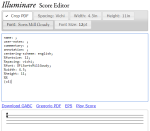Main Page
This website contains 101 pages and 60 sheet music files in JPG and PDF format to use and download.
Famous quotes:
""Gregorian chant is for sacred music what light is for trees: life." (Solange Corbin)"
Latest entries
Info & Utility
Antiphonae
Introitum
Hymnus
Tractus
The Tract (in Latin Tractus, in Ambrosian chant Cantus) is a liturgical chant between the readings, which belongs to the Proper of the Mass. In the Tridentine Mass it replaces the Alleluia verse during Lent, during the Season of Septuagesima, and in Masses for the dead. After the liturgical reform of the Roman rite in 1969, in the acclamation before the Gospel, one may sing instead of the Alleluia during Lent either the verse placed in the Lectionary before the Gospel, or another psalm or a tract as found in the Gradual[1].
Graduals - Gradualia
The gradual, formerly called Responsorium Graduale, is a melismatic inter-lecture chant that belongs to the proper of the Mass. Its name derives from the Latin gradus, step, because originally the singers sang the gradual while remaining on the steps of the ambo.
In the current liturgical order of the Roman rite, it can be sung after the first reading, using the Gregorian or polyphonic repertoire, with the function of an invitation to meditate on the Word heard. More frequently the gradual is not sung and is then replaced by the responsorial psalm prescribed by the missal. During Easter time the gradual is not contemplated, another alleluia chant is performed in its place, with the exception of the octave of Easter.
Psalms - Psalmus
Alleluia - Versus alleluiatici
Sequentia
The sequence, often also called by its Latin name sequentia, is a liturgical musical poetic composition that is recited (or sung) at the end of the second reading while the assembly remains seated until its end and at the Alleluia that acclaims the Gospel one stands up.
The sequence belongs to the proper of the mass: its text therefore varies according to the liturgical occasion celebrated.
Documents and Books
The Gregorian Chant
Trattazioni:
Downloadable Gregorian Chant Books - Official Editions::
Downloadable Gregorian Chant Books - Complementary Editions:
Sacred Music and the Liturgy
Gregorian Chant Books to Buy (Solesmes Abbey)
Note
- ↑ General Instruction of the Roman Missal. Link: https://www.vatican.va/roman_curia/congregations/ccdds/documents/rc_con_ccdds_doc_20030317_ordinamento-messale_it.html











